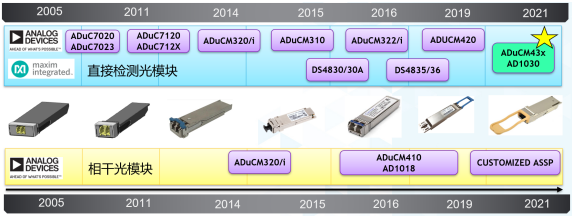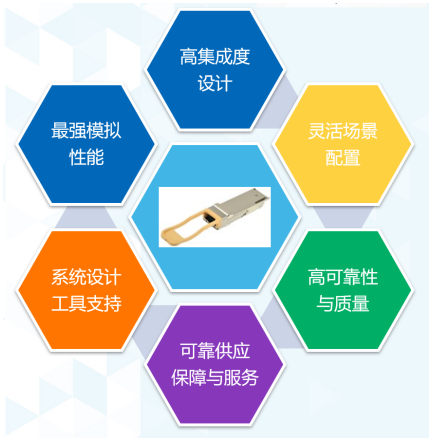The century-long modern history of mankind has achieved an unprecedented rapid technological evolution in the past two decades. Smart IoT, cloud, blockchain, big data, autonomous driving…the endless stream of innovative technologies are subverting the traditional life mode of mankind, and all of these Behind the scenes are all based on high-speed data connection infrastructure. Modern cities are quickly entering the era of 10 Gigabit connections-10 Gigabit enterprise access, 10 Gigabit home broadband access, and 10 Gigabit personal wireless access experience. The industry predicts that by 2030, the global 10G enterprise WiFi penetration rate will reach 40%; the global fiber broadband users will reach 1.6 billion, and the 10G home broadband penetration rate will reach 23%; the total number of global connections will reach 200 billion, and the data generated globally It will reach 1YB, which is 23 times that of 2020.
Behind this, optical communication technology has played a key role. According to the latest report on the global optical module market released by the well-known market research organization LightCounting, the optical module market is worth 8 billion U.S. dollars in 2020 and is expected to increase to 14.5 billion U.S. dollars by 2026, with a compound growth rate of 10.4% in the global optical module market. “Whether it is on the telecommunications side or the data center side, we have seen rapid growth in the demand for optical Modules.” ADI’s optical communication product line market and application manager pointed out at the recent China Optical Expo in the summer.As high performancesemiconductorSolution provider, ADI provides a wealth of control units and optical channels in the optical module application fieldCircuitThe new generation of optical module control solution ADuCM43x, which debuted at the Expo, aims to create an extremely flexible platform solution + excellent system cost competitiveness, and is expected to become the market leader in 400G/800G optical modules. “New favorite”.

ADI Optical Communication Product Line Marketing and Application Manager Summer
The latest one-special multi-function control platform is available on the market, the fourth-generation optical moduleControllerLeading the trend of rapid development
At the Expo site, ADI focused on displaying its rich optical module related product solutions, including the main series of products from the first to the fourth generation of controllers, optical module power solutions, thermoelectric cooler regulator modules, etc. .The control unit passesSingle chip microcomputerRealize the configuration, adjustment and real-time monitoring of the internal components of the optical module. When the module is powered on, the single-chip microcomputer loads and initializes the microcode of each chip. After the module works normally, the single-chip monitors and adjusts the working status of each component in real time.
The fourth-generation optical module controller series ADuCM43x and the ADuCM430-based CMIS4.0 solution, which were launched for the first time on the market, are undoubtedly the “flow responsibility” of the audience. “ADuCM43x series is a new generation of optical module control solution developed by ADI’s local team, which mainly reflects general digital resources + differentiationRAM+ Differentiated analog peripherals + Pin2Pin compatibility, providing an extremely flexible platform solution + excellent system cost competitiveness. “Xiamen pointed out, “ADuCM43x is mainly oriented to 200/400/800G DML/EML/silicon optical module applications. It is optimized for small size, low power consumption, and ease of use for high-speed optical modules, and mainly embodies four major advantages. “
The four major product advantages of ADuCM43x in Xiakou include:
High integration to meet high-speed optical modulesQualcommRoad density requirements. In order to meet the high channel density requirements of high-speed optical modules, this highly integrated solution integrates a multi-channel 12-bit SAR ADC, a multi-channel voltage DAC, a multi-channel current output DAC, and a thermoelectric cooler (TEC) controller. The functions that can be realized by 4 chips are integrated, and the 5mm*5mm 121-pin BGA package is adopted, which is very suitable for the small size of the optical module in the future.
High-performance simulation technology once again highlights ADI’s “housekeeping skills.”The integrated ADC/DAC linearity and noise index are very high, andMCUBoth the TEC controller and the TEC controller have achieved the greatest degree of efficiency optimization, and the power consumption advantage of the scheme is obvious. At the same time, the chip has made a lot of optimizations on the pressure difference between input and output, and the pressure difference between input and output is reduced, so that the power consumption of the chip is further reduced, and the performance is more in line with the needs of the current industry.
Ease of use accelerates product application landing. ADuCM43x is mainly aimed at the application of 200/400/800G DML/EML and silicon optical modules, and has been customized for different application scenarios. It can not only support small size, but also realize the channel of Flash size and analog resources. Flexible configuration of data and other requirements, and even different package sizes can provide options. In addition, for 400G modules, ADuCM43x supports this year’s CMIS4.0 protocol, and at the same time launches supporting software, which can help customers develop their software more quickly to adapt to the CMIS4.0 protocol.
ADI’s local Chinese team develops to better satisfy domestic users and ensure supply chain security. As a new generation of ADI localized optical module control product, ADuCM43x will be able to better meet the design needs of the domestic optical module market and customers.
“ADI is very far-sighted and has been very optimistic about China’s optical communications market. It has been deploying optical communications product lines since 2005. It has a history of nearly 20 years. ADuCM43x has had three generations of products and almost 20 models are completely made by China. The local R&D team completed all the designs and successfully put them on the market, achieving great success, with annual shipments of over 2 million pieces.” Regarding the last key point, Xia especially added and emphasized.

ADI optical communication product layout and evolution
ADI optical module controller four-generation iterative roadmap, witnessing the rapid rise of China’s optical communications
At the Expo site, ADI exhibited a full range of four-generation optical module controls including the first-generation controller ADuC702X/712X, the second-generation ADuCM31x/ADuCM32x, the third-generation ADuCM420/410, and the fourth-generation controller product ADuCM43x. Among them, the earliest ADuC702X/712X is still widely used in optical modules under application scenarios such as GPON/10G/25G/100G. Strengthening the system support for local Chinese customers has always been one of ADI China’s strategic goals.

ADI’s six dimensions create the core competitiveness of optical module product solutions.
“From chip-level support to support for new technologies and product fields, we have a lot of very close and fruitful cooperation with Chinese communication equipment supplier customers, including a lot of work with them to complete product definition and product application development. We are continuing Based on the establishment of a deep partnership with Chinese customers, a series of very successful products have been developed.” Xia Xia said, “We are very optimistic about China’s potential in the field of optical communications. The four generations of products from the ADI R&D center have witnessed and strongly supported This has contributed to the rapid development of China’s optical communications industry.”
In fact, the past ten years has also been a golden period for the rapid development of China’s optical module companies. According to LightCounting’s report data, in 2020, six domestic manufacturers in the top ten global optical module manufacturers will be on the list, dominating the global optical module market, compared to 2010 when only one Chinese company entered the top ten. Today, China’s optical communication module products occupy a leading share of the global market, and ADI optical module controllers are almost universal solutions for these companies. “In the most active market in China, we have to establish a very close bond with our customers, especially a technology-to-technology, engineer-to-engineer bond relationship to help our customers solve the most difficult challenges, and at the same time Help our own products do better.” Xia added, “Benefiting from the construction of data centers and the in-depth layout of 5G networks, the global market share of domestic optical module companies has increased, and the demand for optical module downstream operators has expanded. We are optimistic about the future of Chinese optical module companies. Opportunities for further growth.”
Actively create localized solutions to empower the era of data torrents with a comprehensive product portfolio
As an important measure for ADI to implement its localization strategy in the Chinese market, ADI established the China Product Division and upgraded Analog Devices (Shanghai) Co., Ltd. to Analog Devices Investment Co., Ltd. at the end of last year. As ADI’s headquarters-based operating organization in China, ADI has achieved a more complete layout in the process of localization based on this.
“The establishment of ADI’s China headquarters is based on localization considerations and layout. The launch of the new generation of optical module control products ADuCM43x is a masterpiece of localization, whether it is from the front-end of the product to the IP design, or the back-end packaging and testing. Production and manufacturing are fully localized.” Xia pointed out, “ADI is willing to cooperate with all domestic optical module companies and optical device companies, and is open to integrated packaging at the die level. With these measures, we can provide better services. Locally, this is also ADI’s investment and determination in the optical communications market, especially China’s optical communications market.”

After ADI completes the acquisition of Maxim, it has further enriched its optical module application product portfolio
A small optical module is actually a complex optoelectronic system. In addition to optical devices and core control units, amplifiers, drivers, thermoelectric coolers, power devices, etc. are indispensable. “ADI has a wealth of optical module core components and peripheral devices. These products provide a rich and flexible combination of solutions for optical module manufacturing. For example, our third-generation controller ADuCM410 has 16 ADC channels, but if customers need more Analog channels, ADI also has many general ADC/DACs that can be matched to form a more complete solution, such as AD5770R; in addition, such as ADN8833, as a well-known TEC controller in the industry, continues to have a very wide range of applications in this market and very good Word of mouth.” Speaking of various product solutions, there are many treasures in the summer.
It is worth mentioning that the completion of the acquisition of Maxim by ADI has further enabled ADI to achieve a strong integration in the field of optical communication semiconductors. “Maxim also has a wealth of products and deep technology accumulation in the key components of optical modules such as power supplies, laser drivers, TIAs, and CDRs. Controllers such as the DS4830 and DS4835 series have many applications in the global optical module market. At present, the products of both parties The line is being integrated, and I believe it will provide you with more competitive solutions in the future.” Xia Tian said. With the development of optical modules in the direction of 400G and 800G high-speed communication, small packages, high-speed and high-channel density undoubtedly put forward higher requirements for integrated solutions. For example, ADuCM430 integrates TEC controllers and PMICs on-chip to achieve highly integrated solutions. In the future, ADI will continue to provide a rich product portfolio with more integration and performance advantages in the field of optical modules.